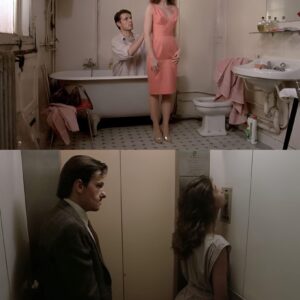Phoebe Waller-Bridge’s Fleabag is one of the most striking and emotionally rich television series in recent memory. Spanning two seasons and a mere 12 episodes, the show packs an immense amount of wit, pain, and raw humanity into its brief runtime. It’s a masterclass in storytelling, blending comedy and tragedy with seamless ease. Fleabag doesn’t just entertain—it cuts deep, offering an unfiltered look at grief, guilt, love, and self-destruction.
A Character Like No Other
At the heart of Fleabag is its titular character, played by Waller-Bridge herself. She is a deeply flawed but endlessly fascinating woman navigating life in London while dealing with unresolved trauma. The show’s signature device—Fleabag breaking the fourth wall to address the audience directly—makes us complicit in her experiences, her mischief, and her pain. This unique storytelling choice transforms the viewer into a confidant, creating a level of intimacy rarely seen in television.
Fleabag is not a conventional protagonist. She’s messy, impulsive, and often morally ambiguous. She sleeps with the wrong people, makes terrible decisions, and actively resists help from those who care about her. Yet, she is never unlikable. Her humor, vulnerability, and sharp self-awareness make her feel real. We don’t just watch her—we understand her.
The Power of Season One: Sex, Grief, and Self-Destruction
The first season of Fleabag introduces us to a woman in crisis. We learn that she has lost her best friend, Boo, to suicide—an event that haunts her every move. The season unfolds as a series of vignettes showcasing Fleabag’s dysfunctional relationships: with her emotionally distant father, her cold and self-absorbed godmother (played masterfully by Olivia Colman), her high-strung sister Claire (Sian Clifford), and a parade of unsuitable lovers.

Sex is a central theme in season one, often portrayed as Fleabag’s primary coping mechanism. She uses it for validation, for escape, for a fleeting sense of control. However, the show never judges her for this; instead, it presents sex as another facet of her complex emotional state. Her relationships are often transactional, highlighting her inability to let herself be truly seen by others. The season builds to a devastating climax as we uncover the truth behind Boo’s death and Fleabag’s role in it. When she finally breaks down, confessing her guilt and self-hatred, it’s a gut-wrenching moment that feels both earned and inevitable.
Season Two: The Godly Love Story
If season one was about self-destruction, season two is about redemption—sort of. The introduction of Andrew Scott’s Hot Priest electrifies the show, giving Fleabag a romantic and spiritual foil who challenges her in ways she hasn’t experienced before. Their chemistry is immediate and undeniable, making their doomed relationship all the more compelling.
Season two is arguably even sharper than its predecessor. While still steeped in humor, it delves deeper into themes of faith, love, and human connection. The writing is tighter, the emotions more refined. Fleabag’s fourth-wall breaks evolve, becoming more interactive. The moment when the Hot Priest notices her addressing the audience is a small but profound disruption of her narrative control, signaling his unique ability to truly see her.

Their relationship is beautiful yet painful. He represents something she can’t have—genuine love, stability, and faith. Their final scene together, in which he chooses God over her, is one of the most heartbreaking moments in recent television history. Yet, it’s also hopeful. Fleabag doesn’t crumble this time. Instead, she walks away with quiet acceptance, signaling her growth.
Writing and Direction: A Perfect Balance
Waller-Bridge’s writing is razor-sharp, filled with rapid-fire dialogue, dark humor, and moments of staggering emotional weight. The show’s ability to shift from laugh-out-loud comedy to deep sadness in seconds is one of its greatest strengths. There’s no wasted word or moment; everything serves a purpose.
The direction is equally masterful. The use of close-ups, quick cuts, and silent beats enhances the show’s intimacy. The cinematography captures Fleabag’s isolation beautifully, often framing her alone even in crowded spaces. The music choices, especially the choral score in season two, add a haunting, almost sacred quality to the story.
The Supporting Cast: A Gallery of Complex Characters

While Fleabag is the undeniable core of the show, its supporting characters are just as rich and compelling.
- Claire (Sian Clifford): Fleabag’s tightly wound sister is the perfect counterbalance to her chaos. Their relationship is fraught but deeply loving. Claire’s storyline—escaping an unhappy marriage and finally embracing what she wants—is one of the most satisfying arcs in the series.
- The Godmother (Olivia Colman): A delightfully passive-aggressive villain, she embodies toxic, performative kindness. Colman plays her with a sickly sweetness that makes every interaction excruciatingly uncomfortable.
- The Father (Bill Paterson): He is emotionally inept, unable to connect with his daughters, yet his quiet sadness is deeply moving.
- The Hot Priest (Andrew Scott): One of television’s most charismatic love interests, he is both irreverent and deeply devout. His presence shakes Fleabag’s world in ways she never expected.
Why Fleabag Resonates So Deeply
What makes Fleabag so special is its raw honesty. It’s a show about a woman who is deeply flawed, yet profoundly human. It’s about grief, but also about healing. It’s about loneliness, but also about the desperate need for connection.
At its core, Fleabag is a reflection of modern womanhood—messy, complex, and full of contradictions. It doesn’t sugarcoat pain or provide easy answers. Instead, it presents life as it is: sometimes hilarious, sometimes unbearable, but always worth experiencing.
Final Thoughts
Fleabag is a rare gem in television—a show that is both wildly entertaining and deeply profound. Phoebe Waller-Bridge’s performance is nothing short of extraordinary, making Fleabag one of the most unforgettable characters in recent memory. The series doesn’t overstay its welcome, ending exactly when it should, leaving a lasting impact on those who watch it.
Few shows manage to balance humor and heartbreak as masterfully as Fleabag. It’s a story that stays with you long after it ends, making you laugh, cry, and—perhaps most importantly—feel a little less alone.





